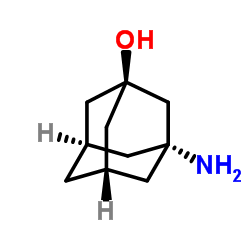Liquid chromatographic methods for the determination of vildagliptin in the presence of its synthetic intermediate and the simultaneous determination of pioglitazone hydrochloride and metformin hydrochloride.
Spencer S Walse, Hakan Karaca
Index: Int. J. Biomed. Sci. 7(3) , 201-8, (2011)
Full Text: HTML
Abstract
Ozone fumigation was explored as a means for degrading organic fungicide residues on fresh produce. Fungicides sorbed onto model abiotic glass surfaces or onto grape berries were fumigated separately in a flow-through chamber. Gaseous ozone at a constant concentration of 150 ± 10 ppmv (μL·L(-1)) selectively oxidized fungicides sorbed to model surfaces. Over 140 min, boscalid and iprodione levels did not change significantly based on a single-factor analysis of variance (ANOVA) at the 95% level of confidence (p = 0.05); however, pseudo-first-order losses resulted in observable rate constants of ozonolysis, k(ozonolysis) (min(-1)), of 0.0233 ± 0.0029 (t(1/2) ≈ 29.7 min), 0.0168 ± 0.0028 (t(1/2) ≈ 41.3 min), and 0.0127 ± 0.0010 (t(1/2) ≈ 54.6 min) for fenhexamid, cyprodinil, and pyrimethanil, respectively. The relative degradation of fungicides on berries at gaseous ozone concentrations of 900 ± 12 ppmv (μL·L(-1)) over 2 h was similar to that on glass; decreases in residue concentration were observed for only fenhexamid (∼ 64%), cyprodinil (∼ 38%), and pyrimethanil (∼ 35%) with corresponding k(ozonolysis) (min(-1)) of 0.0085 ± 0.0021 (t(1/2) ≈ 81.5 min), 0.0039 ± 0.0008 (t(1/2) ≈ 177.7 min), and 0.0036 ± 0.0007 (t(1/2) ≈ 192.5 min). Heterogeneous rate constants of gaseous ozone reacting with a sorbed fungicide, k(O(3)) (M(-1)·min(-1)), were calculated for both surfaces and indicate losses proceed ∼ 15-fold slower on grapes. The kinetics and mechanism of fungicide removal, supported by gas chromatography- and liquid chromatography-mass spectrometry product analyses, is discussed in the context of facilitating compliance with maximum residue level (MRL) tolerances for fresh produce.
Related Compounds
| Structure | Name/CAS No. | Molecular Formula | Articles |
|---|---|---|---|
 |
3-Amino-1-hydroxyadamantane
CAS:702-82-9 |
C10H17NO |
|
Adamantyl analogues of paracetamol as potent analgesic drugs...
2014-01-01 [PLoS ONE 9(12) , e113841, (2014)] |
|
Further calculations on solubility of 3-amino-1-adamantanol ...
[J. Mol. Liq. 219 , 211-215, (2016)] |
|
A Facile and Economical Method to Synthesize Vildagliptin. D...
[Lett. Org. Chem. 11(10) , 780-784, (2014)] |
|
NOVEL TRICYCLIC CYANOPYRROLIDINE DERIVATIVES AS DPP4 INHIBIT...
[Rasayan J. Chem. 6(3) , 230-237, (2013)] |
|
1-[[(3-hydroxy-1-adamantyl)amino]acetyl]-2-cyano-(S)-pyrroli...
2003-06-19 [J. Med. Chem. 46 , 2774-2789, (2003)] |